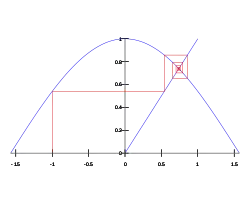Dottie number
In mathematics, the Dottie number is a constant that is the unique real root of the equation

where the argument of is in radians. The decimal expansion of the Dottie number is .[1]
It can be trivially proven that the equation has only one solution by the intermediate value theorem in the real plane. It is the single real-valued fixed point of the cosine function and is a nontrivial example of a universal attracting fixed point. It is also a transcendental number because of the Lindemann-Weierstrass theorem.[2] The generalised case for a complex variable has infinitely many roots, but unlike the Dottie number, they are not attracting fixed points.
Using the Taylor series of the inverse of at (or equivalently, the Lagrange inversion theorem), the Dottie number can be expressed as the infinite series where each is a rational number defined for odd n as
The name of the constant originates from Samuel Kaplan (2007) and refers to a French professor who observed the number after by repeatedly pressing the cosine button on her calculator.[3]
Notes
- Kaplan does not give an explicit formula for the terms of the series, which follows trivially from the Lagrange inversion theorem.
References
- "OEIS A003957". oeis.org. Retrieved 2019-05-26.
- Eric W. Weisstein. "Dottie Number".
- Kaplan, Samuel R (February 2007). "The Dottie Number" (PDF). Mathematics Magazine. 80: 73. doi:10.1080/0025570X.2007.11953455. S2CID 125871044. Retrieved 29 November 2017.
- "OEIS A302977 Numerators of the rational factor of Kaplan's series for the Dottie number". oeis.org. Retrieved 2019-05-26.
- "A306254 - OEIS". oeis.org. Retrieved 2019-07-22.
External links
- Miller, T. H. (Feb 1890). "On the numerical values of the roots of the equation cosx = x". Proceedings of the Edinburgh Mathematical Society. 9: 80–83. doi:10.1017/S0013091500030868.
- Salov, Valerii (2012). "Inevitable Dottie Number. Iterals of cosine and sine". arXiv:1212.1027.
- Azarian, Mohammad K. (2008). "ON THE FIXED POINTS OF A FUNCTION AND THE FIXED POINTS OF ITS COMPOSITE FUNCTIONS" (PDF). International Journal of Pure and Applied Mathematics.